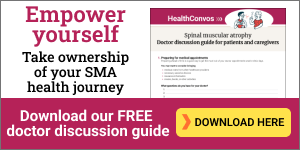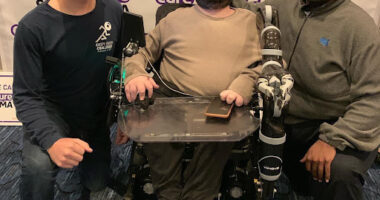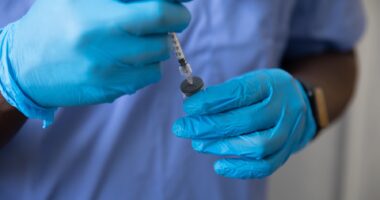
The patient-provider relationship: Optimizing SMA clinics
Kevin Schaefer, who lives with SMA type 2, and neurologist Edward Smith, MD, share the prep work they do to maximize efficiency during their clinic visits.
 Find a specialist near you
Find a specialist near you
Transcript
Kevin: As far as preparing for doctor appointments, I think the biggest thing that helps me is going in with knowing what issues I wanna discuss.
I mean, Dr. Smith, you mentioned the importance of PTs and OTs and social worker, and I totally agree. And that’s a lot of how I got my JACO robotic arm. Because when I started losing arm strength — as far as back as when I was in high school — we were constantly looking for devices to help with that so that I can be more independent. And it was OT and PT that helped me discover the JACO arm and got me on that process. And you know, it takes a team to get equipment like that approved.
But that’s just an example. And so, you know, if I’m going into a doctor appointment and I know it’s something like that — whether it’s my arm, upper body strength, or if I’m having fatigue, or if I’m dealing with pain — identifying those issues ahead of time and bringing those to appointments really helps.
And so, you know, I may just, it may be as simple as just, you know, jotting down a note on my phone or whatever, just as long as I remember it before the appointment and am prepared to discuss those topics so that we can discuss strategies during the appointment for how to address those issues.
Dr. Smith: I think for us as a clinic, as a clinic team, communicating with each other before clinic and kind of reviewing each patient.
We would — our clinic is on Fridays and we would have a team meeting on Thursday morning. Usually a video meeting, but with the entire team. And we would just kind of go through the list of patients who were scheduled for the following day and quick review their clinic notes and sort of any action items or anything in our — what we call our assessment and plan — what were the needs and then so that we can figure out if those were addressed at the upcoming visit.
And then also, we would also try to call when we would confirm that a patient or family was coming to the appointment, the next appointment, and ask if there were one or two items in particular that they’d like to address at that appointment. We try to address more than that, but we wanted to make sure that we would address what the patient or family were really interested in addressing.
It can get busy in clinic and things can get missed. We can get sidetracked on other things. And then before you know it, right, before you know it, three or four hours have gone by and it’s time to check out.
And so preparation — and it doesn’t take a whole lot, but some amount of preparation and communication with the team — in anticipation for that visit is super valuable.
Recent Posts
- Looking forward to the new year with more confidence than ever
- Motor unit changes track with SMA severity, new study shows
- SMA community honors legacy of disability rights activist Alice Wong
- Teamwork and faith helped my parents raise children with SMA
- SMA treatment Evrysdi shows multiple benefits for adults








